Cioppino (Fisherman’s Stew)
This post may contain affiliate links. Read my full disclosure policy.
Cioppino, a hearty Italian-American stew made with a medley of fresh seafood in a rich tomato and wine broth, perfectly captures the taste of the sea.
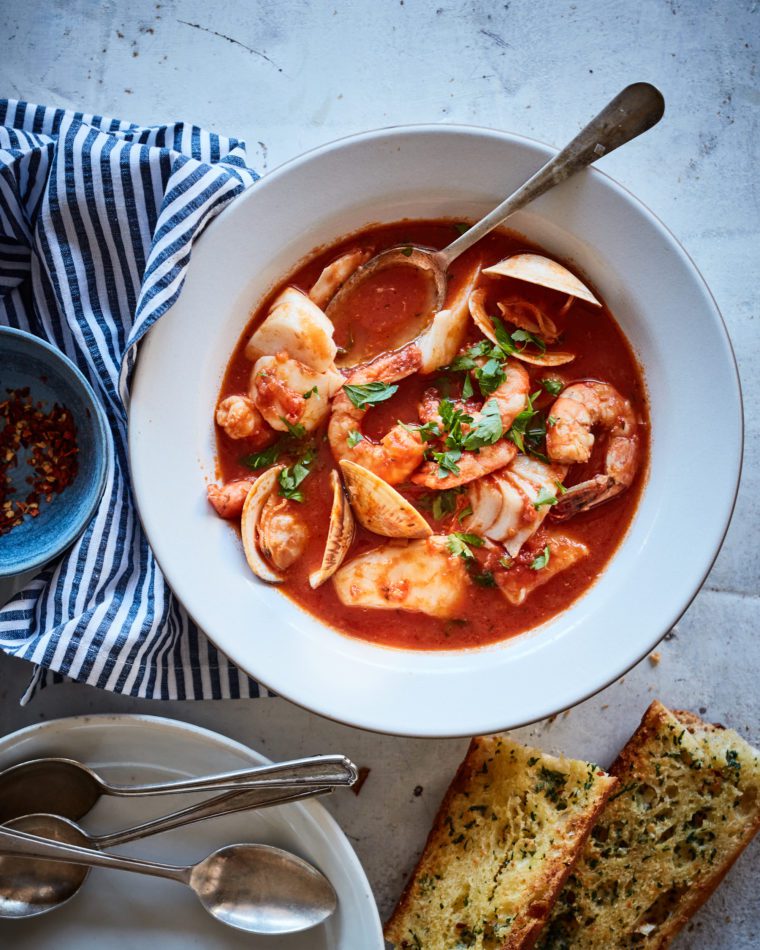
Photo by Johnny Miller, Clarkson Potter 2021
Brimming with fresh seafood in a tomato and wine broth that tastes like the sea, cioppino (pronounced chuh-pee-noh) is a rustic Italian-American fish stew. Its origins can be traced back to Italian immigrant fishermen in San Francisco, but my personal favorite version can be found at Portofino, a picturesque bayside restaurant in Longboat Key, Florida. Every year, my family gathers at Portofino over the holidays to enjoy the cioppino, and the chef was kind enough to share his recipe with me.
To make the recipe more accessible for home cooks, I have modified it by using fewer types of seafood (though crab, lobster, or mussels would all make wonderful additions). To fully enjoy this wonderful stew, serve it with garlic bread, focaccia, or a baguette to soak up the flavorful broth—and be sure to set out an extra bowl for shells and plenty of napkins.
Table of Contents
“I’m a culinary trained chef of 25 years working on private yachts now…All I can say is wow!!!! The broth is spot on.”
What You’ll Need To Make Cioppino
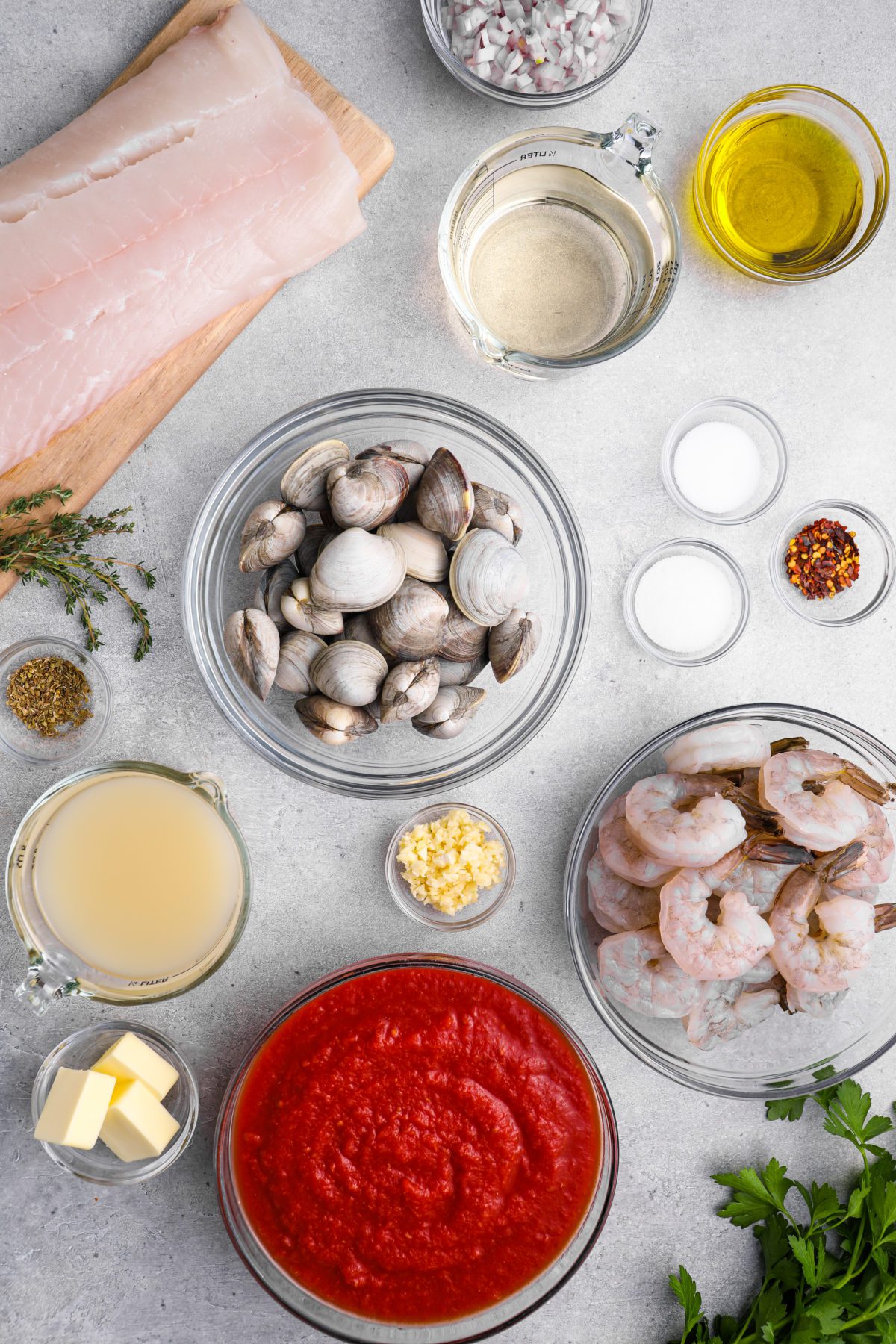
- Shallots and Garlic: These aromatics form the flavor foundation for the stew.
- White Wine: Adds acidity and brightness, complementing the seafood.
- Canned Crushed Tomatoes: Gives the cioppino its rich tangy flavor and vibrant color.
- Clam Juice: Lends a briny depth that makes cioppino truly taste like the sea.
- Crushed Red Pepper Flakes, Oregano, Thyme: This combination of spices and herbs adds warmth, earthiness, and a hint of heat.
- Firm-fleshed Fish Fillets: Chunks of halibut, cod, salmon, or snapper absorb the broth’s savory broth and contribute their own delicate taste to the stew.
- Butter: Added at the end of the cooking process to give the cioppino and a velvety finish and round out the acidity of the wine and tomatoes.
- Littleneck Clams: A traditional cioppino ingredient, the clams open up during cooking to release their sweet, briny juices into the broth. (See the FAQs for how to store and clean them.)
- Shrimp: With their slightly sweet, meaty texture, shrimp cook quickly and absorb the surrounding flavors.
- Jump to the printable recipe for precise measurements
Step-by-Step Instructions
To cook the stew, heat 1/4 cup of the oil over medium heat. Add the shallots and cook until soft and translucent, about 5 minutes. Add the garlic and for 1 minute more. Do not brown.
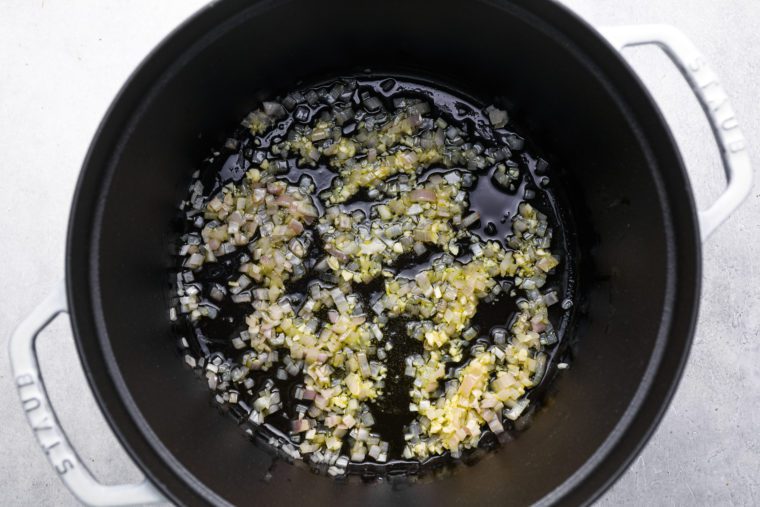
Add the wine and increase the heat to high. Boil until the wine is reduced by about half, 3 to 4 minutes.
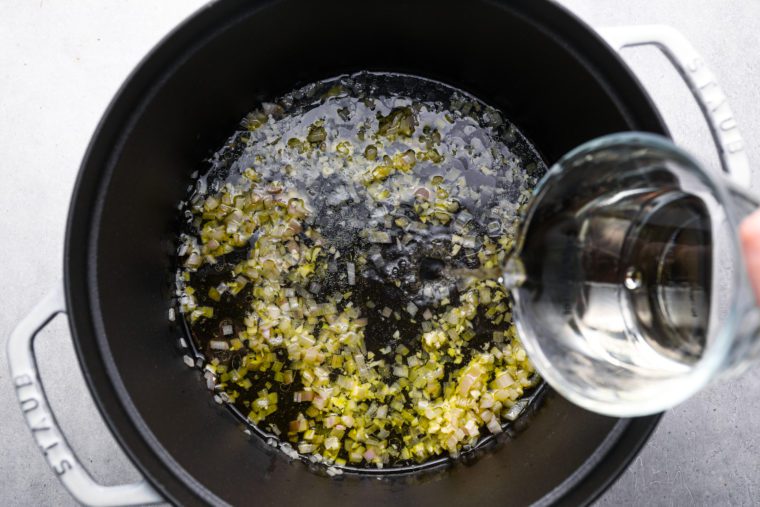
Add the crushed tomatoes, clam juice, sugar, 1 teaspoon of the salt, red pepper flakes, oregano, thyme sprigs, and 1 cup of water. Bring to a boil; reduce the heat and simmer, covered, for 25 minutes.
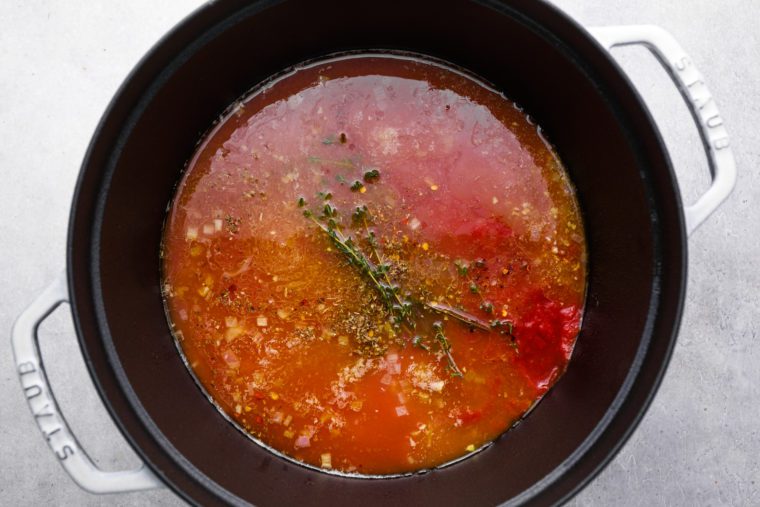
Meanwhile, while the stew is simmering, toss the fish with the remaining 2 tablespoons oil and remaining 3/4 teaspoon salt. Arrange the fish on the prepared baking sheet.
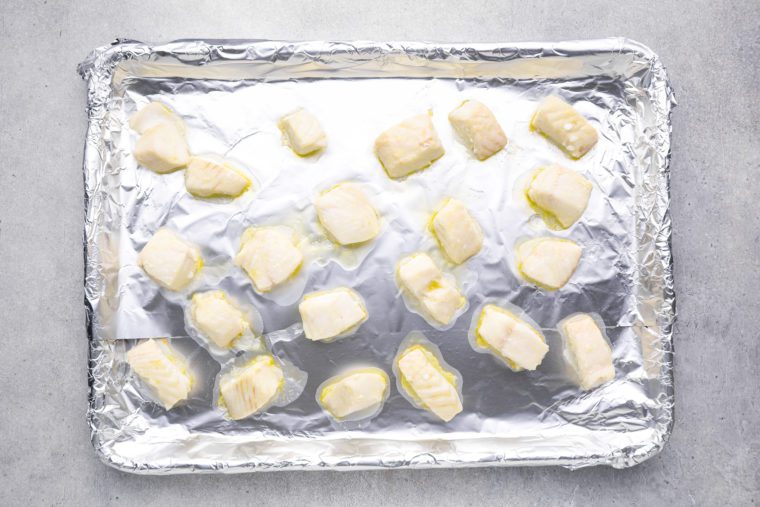
Bake for about 10 minutes at 400°F, or until just cooked through. Cover and keep warm until ready to serve. (Note: most cioppino recipes call for the fish to be simmered in the broth but I prefer to bake it separately so that it doesn’t fall apart or overcook.)
When the stew is done simmering, remove and discard the thyme sprigs and stir in the butter.
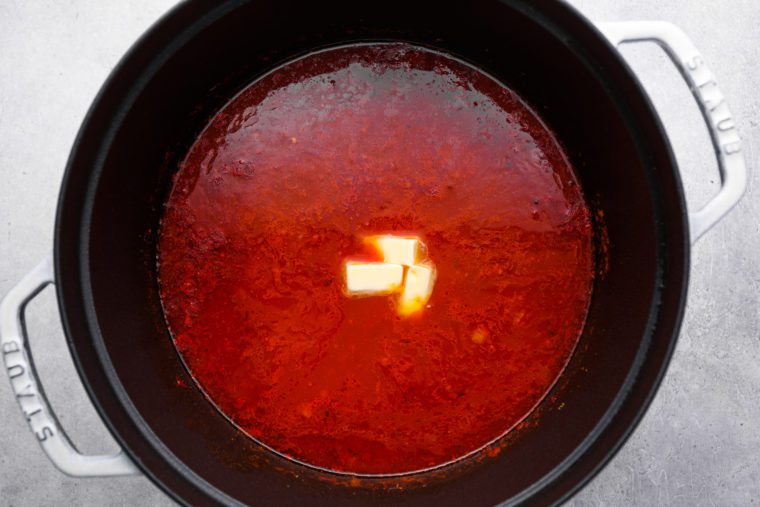
Add the clams and bring the stew back to a simmer.
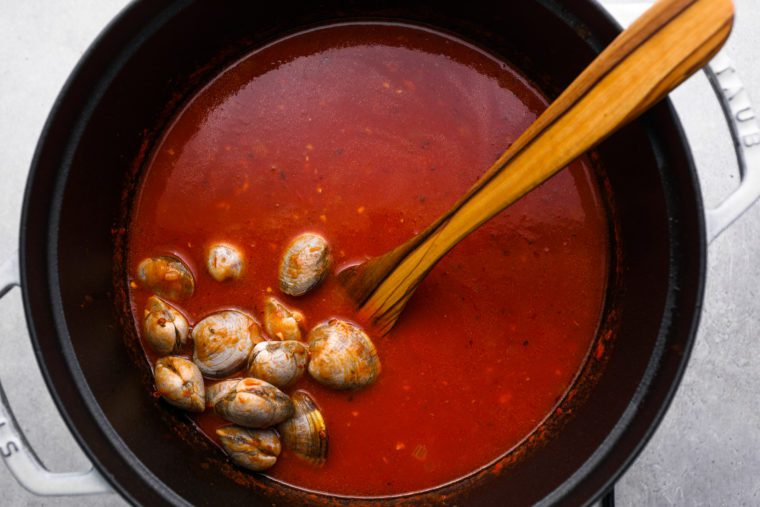
Cover and cook for about 6 minutes, until the clams have mostly opened. Gently stir in the shrimp and bring the stew back to a simmer.
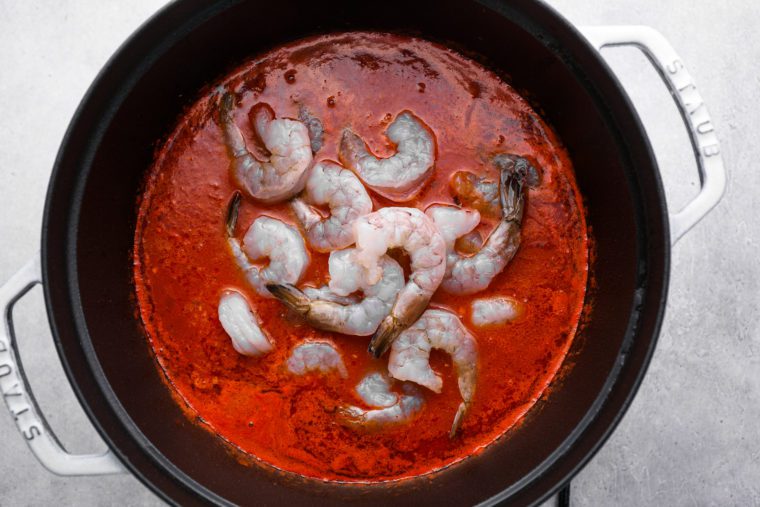
Cover and cook until the shrimp are just cooked through and the clams are completely opened, about 5 minutes. Discard any unopened clams. Add the chopped thyme, then taste the stew and adjust seasoning, if necessary.
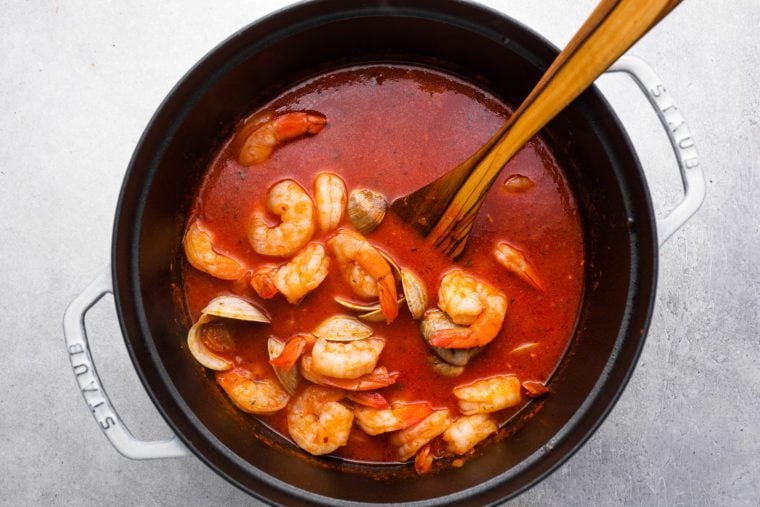
Divide the warm fish into serving bowls. Ladle the stew over top, dividing the clams and shrimp evenly amongst the bowls. Garnish with parsley, if using, and serve with garlic bread, focaccia, or a baguette for sopping up the broth.
Frequently Asked Questions
First, make sure all of the shells are tightly closed. If any clams are open, gently tap them against the countertop; if they are alive, they will close their shells. Discard any clams that do not close their shells or that have cracked or chipped shells.
Before cooking the stew, place the clams in a bowl and cover them with cool tap water. Let them sit for 20 minutes to an hour. During this time, the clams will expel sand from inside their shells. When you’re ready to cook, lift each clam from the water and rinse it, scrubbing if necessary, to get rid of any grit from the surface. (Note that most supermarkets sell farm-raised clams, which are already quite clean, so you may not find a lot of grit or sand.)
Clams are usually sold in a mesh bag because they are alive and need to breathe. If your fishmonger places them in a plastic bag, remove them from the bag immediately when you get home from the supermarket and place them in a bowl covered with a damp cloth in the refrigerator.
You can make the cioppino, without the seafood, up to 2 days ahead of time. Store it in the refrigerator, covered. When ready to serve, bake the fish and bring the stew to a simmer before adding the seafood.

Video Tutorial
You May Also Like
Cioppino (Fisherman's Stew)
Cioppino, a hearty Italian-American stew made with a medley of fresh seafood in a rich tomato and wine broth, perfectly captures the taste of the sea.
Ingredients
- ¼ cup + 2 tablespoons extra-virgin olive oil, divided
- ⅔ cup finely chopped shallots, from about 3 shallots
- 3 cloves garlic, minced
- 1 cup white wine
- 1 (28 oz) can crushed tomatoes
- 2 (8 oz) bottles clam juice
- 2 teaspoons sugar
- 1¾ teaspoons salt, divided
- ½ teaspoon crushed red pepper flakes
- ½ teaspoon dried oregano
- 7 sprigs fresh thyme, plus 1 teaspoon fresh chopped thyme
- 1½ pounds firm-fleshed fish fillets, such as halibut, cod, salmon, snapper, etc., cut into 2-inch pieces
- 3 tablespoons unsalted butter
- 1½ pounds (about 18) littleneck clams, scrubbed (see note)
- 1½ pounds extra large raw shrimp, peeled and deveined
- Fresh chopped Italian parsley, for garnish (optional)
Instructions
- Preheat the oven to 400°F and set an oven rack in the middle position. Line a baking sheet with aluminum foil and set aside.
- In a large pot, heat ¼ cup of the oil over medium heat. Add the shallots and cook, stirring frequently, until soft and translucent, about 5 minutes. Add the garlic and cook, stirring constantly, for 1 minute more. Do not brown.
- Add the wine and increase the heat to high. Boil until the wine is reduced by about half, 3 to 4 minutes.
- Add the crushed tomatoes, clam juice, sugar, 1 teaspoon of the salt, red pepper flakes, oregano, thyme sprigs, and 1 cup of water. Bring to a boil; reduce the heat and simmer, covered, for 25 minutes.
- Meanwhile, while the stew is simmering, toss the fish with the remaining 2 tablespoons oil and remaining ¾ teaspoon salt. Arrange the fish on the prepared baking sheet and bake for about 10 minutes, or until just cooked through. Cover and keep warm until ready to serve.
- When the stew is done simmering, remove and discard the thyme sprigs and stir in the butter. Add the clams and bring the stew back to a simmer. Cover and cook for about 6 minutes, until the clams have mostly opened. Gently stir in the shrimp and bring the stew back to a simmer; cover and cook until the shrimp are just cooked through and the clams are completely opened, about 5 minutes. Discard any unopened clams. Add the chopped thyme, then taste the stew and adjust seasoning, if necessary.
- Divide the warm fish into serving bowls. Ladle the stew over top, dividing the clams and shrimp evenly amongst the bowls. Garnish with parsley, if using, and serve with garlic bread, focaccia, or a baguette for sopping up the broth. Set out a second bowl for shells and plenty of napkins.
- Make Ahead: The stew, without seafood, can be made 2 days ahead and stored in the refrigerator, covered. When ready to serve, bake the fish and bring the stew to a simmer before adding the seafood.
- Note: Littleneck clams are readily available at most supermarkets and are usually sold in a mesh bag because they are alive and need to breathe. If your fishmonger places them in a plastic bag, remove them from the bag immediately when you get home from the supermarket and place them in a bowl covered with a damp cloth in the refrigerator. To prepare the clams for cooking, first, check that they are alive by making sure all of the shells are tightly closed. If any clams are open, gently tap them against the countertop; if they are alive, they will close their shells. Discard any clams that do not close their shells or that have cracked or chipped shells. To clean, place all of the clams in a bowl and cover them with cool tap water. Let the clams sit for 20 minutes to an hour. During this time, the clams will expel sand from inside their shells. When you’re ready to cook, lift each clam from the water and rinse it, scrubbing if necessary, to get rid of any grit from the surface. (Note that most supermarkets sell farm-raised clams, which are already quite clean, so you may not find a lot of grit or sand.)
Pair with
Nutrition Information
Powered by ![]()
- Per serving (6 servings)
- Calories: 575
- Fat: 23 g
- Saturated fat: 6 g
- Carbohydrates: 20 g
- Sugar: 9 g
- Fiber: 4 g
- Protein: 69 g
- Sodium: 1,650 mg
- Cholesterol: 287 mg
This website is written and produced for informational purposes only. I am not a certified nutritionist and the nutritional data on this site has not been evaluated or approved by a nutritionist or the Food and Drug Administration. Nutritional information is offered as a courtesy and should not be construed as a guarantee. The data is calculated through an online nutritional calculator, Edamam.com. Although I do my best to provide accurate nutritional information, these figures should be considered estimates only. Varying factors such as product types or brands purchased, natural fluctuations in fresh produce, and the way ingredients are processed change the effective nutritional information in any given recipe. Furthermore, different online calculators provide different results depending on their own nutrition fact sources and algorithms. To obtain the most accurate nutritional information in a given recipe, you should calculate the nutritional information with the actual ingredients used in your recipe, using your preferred nutrition calculator.

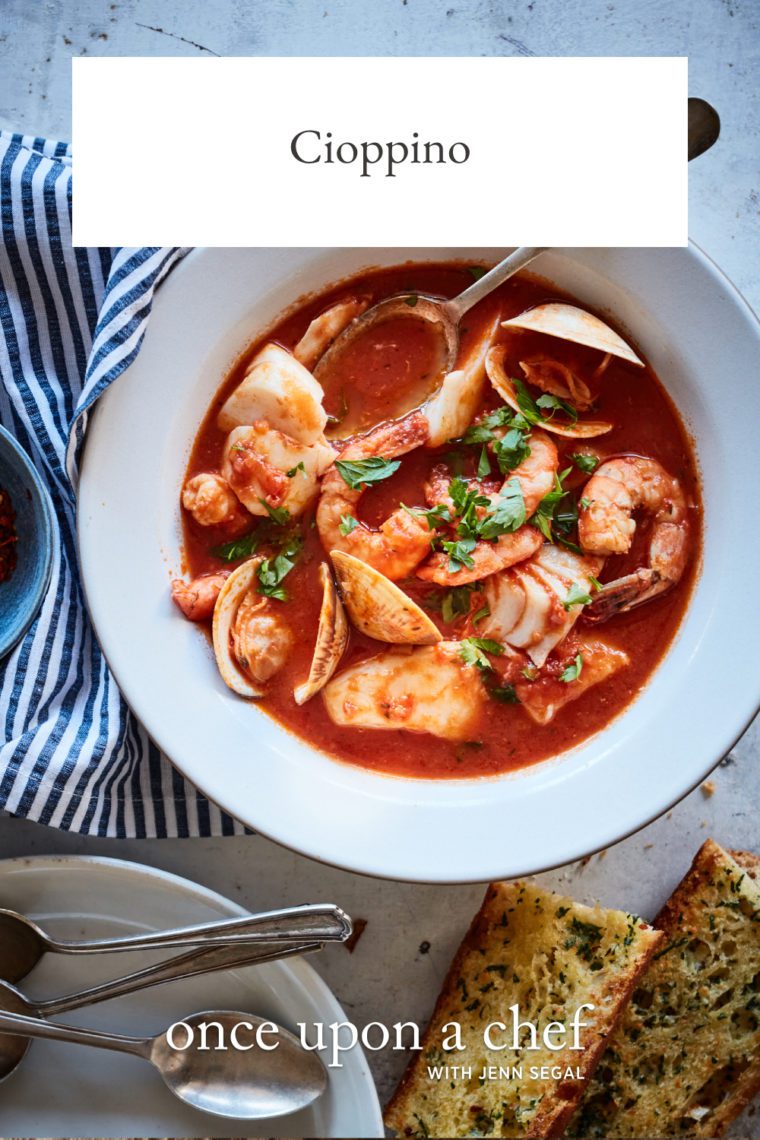
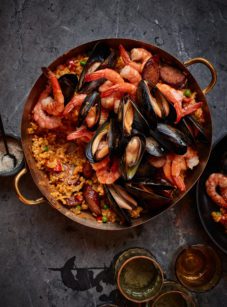

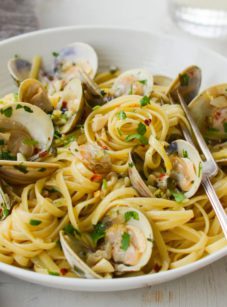
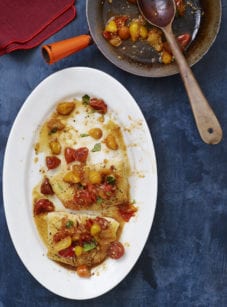

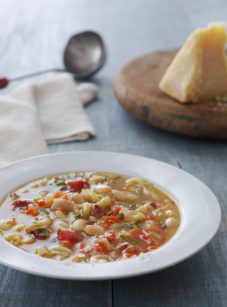
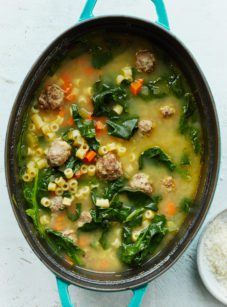
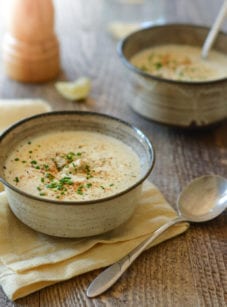
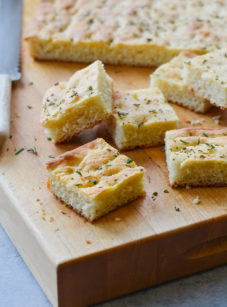
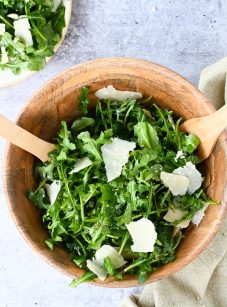
Surprisingly easy and a huge success – my friends are still emailing me 24 hours later to tell me how great this was! I paired with your Focaccia Bread and Caesar salad – both also easy and huge hits!
Perfect Timing! Crabmeat in fridge that had to be eaten today. This recipe was a healthier choice than my usual creamy dip, spread and cassarole recipes. Didn’t lose out on flavor either. It was scrumptious, right down to the last spoonful!!
Looks delicious but agree with Cathy about the sodium content . It’s off the chart! Any suggestions on how this could be lessened without losing flavor?
Hi Carol, There are a few ways to reduce the sodium. You could omit or reduce the salt, but I think you’ll find the broth bland if you cut it too much. You could replace all or some of the shellfish with more fish, as shellfish are very high in sodium. And you could also replace the clam juice with low sodium fish stock. All of those changes would make a big difference in terms of sodium. Hope that helps!
This looks delicious. The sodium content per serving is quite high. Is there more sodium that just the added salt? Thanks.
Hi Cathy, Clam juice and seafood, especially shellfish, are very high in sodium.
Helloooo, new subscriber and a home cooking dad. I loved this dish and plan to make it better the second time…whoops. I destroyed the shrimp by over cooking them- it doesn’t take much. I love your site, delicious looking food, the photography is amazing also. Nice job! Gary/Sarasota Fl.
This looks delish, the clams open with so much liquid? I you thought you had to steam them in a small amount of liquid for the to open. I want to make this next week for company.
They definitely open, Sherri. Hope you enjoy it, and please come back and let me know how it turns out.
Hello! I can’t get clam juice where I live. I was thinking that making a broth from shrimp shells, might work, but was concerned that it might not be strong enough. What would you suggest as an alternative? Thanks!
Hi Adele, I think making a broth with shrimp shells will definitely work — and it will be more economical to boot.
Thanks Jenn – making it tomorrow! 🙂
Hi Jenn,
My family keeps kosher in the home, so we can’t do the shell fish, but I like the idea of a fish stew with the other components here. Do you have any suggestions for boosting the “Seafood,” flavor without the clam juice etc…Thanks in advance for your thoughts…Love your stuff!
Steve
Hi Steve, You could definitely use fish stock. Hopefully you can find a kosher one, as making it from scratch is kind of a pain :).
I think 4 out of 5 recipes I use every week are off of here! I’m so in love. Making this TONIGHT! Can I substitute clams with mussels? We’re not big on clams.
Absolutely, Celeste – any seafood will work in this recipe so feel free to use whatever you like/have on hand. So glad you’re enjoying the recipes!
Another question, you mentioned you can cook the fish in the stew? When would you add them in doing it this way?
I’d add it with the clams; just be gentle when stirring as the fish will fall apart easily once it’s cooked. Also, you can omit the additional 3/4 teaspoon salt for the fish if you cook it this way.
Thanks once again! Made it for my family tonight and everyone loved it. A real hit!
What can I use to replace the wine? (I don’t consume alcohol).
Hi Iman, I think more clam juice plus 1 tablespoon lemon juice would be a good substitute for the wine in this recipe. Please let me know how it turns out if you try it this way.
I tried this and it was good, but I think the original re pie (with the wine) likely makes this recipe. A substitute left it lacking of that strong flavour/kick. Would cider vinegar, soy sauce, or grape juice work to replace the wine?
Hi Iman, Yes, the wine does add depth of flavor and acidity – you might try adding a little lemon juice to taste at the end to brighten it up.